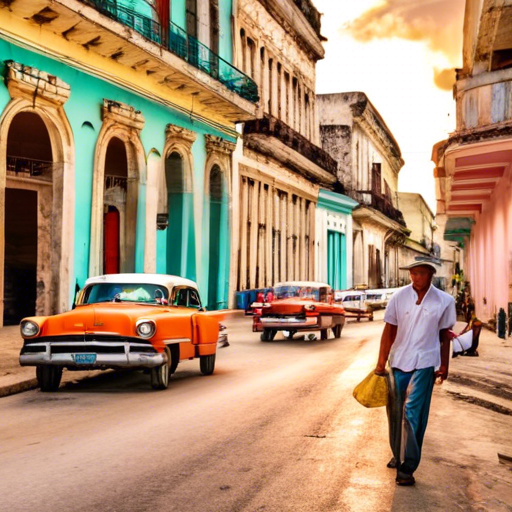uncover the best cultural sites in cuba

Uncover the Best Cultural Sites in Cuba
As we delve into the rich cultural tapestry of Cuba, we uncover a nation brimming with history, art, and vibrant traditions. From the colonial architecture of Havana to the Afro-Cuban rhythms of Santiago, Cuba offers an unparalleled cultural experience. This article aims to guide you through the most significant cultural sites in Cuba, ensuring your visit is both enlightening and memorable.
Havana: The Heartbeat of Cuban Culture
Havana, the capital city, is a treasure trove of cultural landmarks. Its streets are lined with colonial-era buildings, museums, and vibrant public squares. The city's unique blend of old-world charm and modern vibrancy makes it a must-visit destination.
Old Havana (Habana Vieja)
Old Havana, a UNESCO World Heritage site, is a living museum of Spanish colonial architecture. Walking through its cobblestone streets, one can witness the grandeur of the past.
- Plaza de la Catedral: Home to the stunning Cathedral of Havana, this square is a perfect example of Cuban Baroque architecture.
- Plaza Vieja: A bustling square surrounded by restored colonial buildings, cafes, and galleries.
- El Capitolio: This iconic building, resembling the U.S. Capitol, is a symbol of Havana's historical significance.
El Malecón
The Malecón is a broad esplanade, roadway, and seawall stretching for 8 kilometers along the coast. It is a popular spot for both locals and tourists to enjoy the sea breeze and stunning sunsets.
- Historical Significance: Built in the early 20th century, the Malecón has witnessed numerous historical events.
- Cultural Hub: It is a gathering place for musicians, artists, and street performers, making it a vibrant cultural hub.
Santiago de Cuba: The Cradle of Afro-Cuban Culture
Santiago de Cuba, the second-largest city, is known for its rich Afro-Cuban heritage. The city's cultural landscape is deeply influenced by African traditions, making it a unique destination.
Castillo del Morro
This fortress, overlooking the Bay of Santiago, is a UNESCO World Heritage site. It offers a glimpse into Cuba's colonial past and its strategic importance in the Caribbean.
- Historical Exhibits: The fortress houses a museum with exhibits on piracy, colonial history, and the Spanish-American War.
- Stunning Views: Visitors can enjoy panoramic views of the bay and the surrounding landscape.
Casa de la Trova
Casa de la Trova is a legendary music venue where traditional Cuban music thrives. It is a must-visit for anyone interested in the island's musical heritage.
- Live Performances: The venue hosts nightly performances by some of the best local musicians.
- Musical Heritage: It is a hub for genres like Son, Trova, and Bolero, which are integral to Cuban culture.
Trinidad: A Colonial Gem
Trinidad, another UNESCO World Heritage site, is a beautifully preserved colonial town. Its colorful buildings and cobblestone streets transport visitors back in time.
Plaza Mayor
The heart of Trinidad, Plaza Mayor, is surrounded by grand colonial buildings and museums. It is a perfect starting point for exploring the town.
- Museo Romántico: Housed in a former mansion, this museum showcases 19th-century furnishings and artifacts.
- Iglesia Parroquial de la Santísima Trinidad: This church, with its neoclassical facade, is a prominent landmark in the plaza.
Valle de los Ingenios
Just outside Trinidad lies the Valle de los Ingenios, a valley that was once the center of Cuba's sugar industry. It is a testament to the island's economic history.
- Historical Significance: The valley is dotted with the ruins of sugar mills, slave quarters, and manor houses.
- Scenic Beauty: The lush landscape and historical sites make it a picturesque destination.
Viñales: A Natural and Cultural Paradise
Viñales, located in the Pinar del Río province, is renowned for its stunning natural landscapes and traditional Cuban culture. The town and its surrounding valley offer a unique blend of natural beauty and cultural heritage.
Viñales Valley
The Viñales Valley, a UNESCO World Heritage site, is famous for its dramatic karst landscapes and traditional tobacco farms. It is a haven for nature lovers and cultural enthusiasts alike.
- Mogotes: These limestone hills are a distinctive feature of the valley's landscape.
- Tobacco Farms: Visitors can tour traditional tobacco farms and learn about the cigar-making process.
Casa de la Cultura
The Casa de la Cultura in Viñales is a cultural center that hosts various events and activities. It is a great place to experience local art and traditions.
- Art Exhibitions: The center showcases works by local artists, reflecting the region's cultural heritage.
- Music and Dance: Visitors can enjoy live music and dance performances, including traditional Cuban genres.
Conclusion
Cuba's cultural sites offer a fascinating glimpse into the island's rich history and vibrant traditions. From the colonial splendor of Havana and Trinidad to the Afro-Cuban rhythms of Santiago and the natural beauty of Viñales, each destination provides a unique cultural experience. Whether you are a history buff, an art lover, or a music enthusiast, Cuba has something to offer. For more travel tips and destination guides, visit this travel site.
FAQ
| Question | Answer |
|---|---|
| What is the best time to visit Cuba? | The best time to visit Cuba is from November to April, during the dry season. |
| Do I need a visa to visit Cuba? | Yes, most visitors need a tourist visa to enter Cuba. Check with your local Cuban embassy for specific requirements. |
| Is Cuba safe for tourists? | Yes, Cuba is generally safe for tourists. However, it is always advisable to take standard precautions. |
| What currency is used in Cuba? | Cuba uses the Cuban Peso (CUP) and the Cuban Convertible Peso (CUC). The CUC is primarily used by tourists. |
For more information on planning your trip to Cuba, visit this travel resource.
